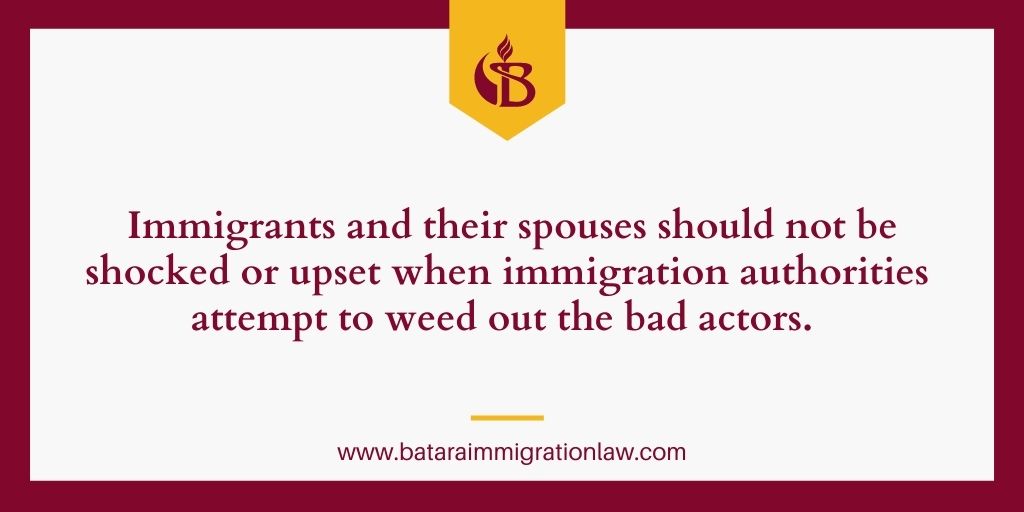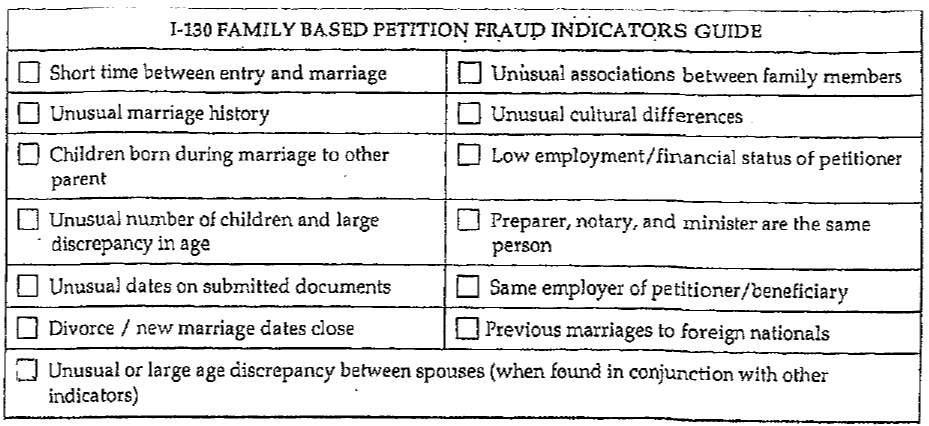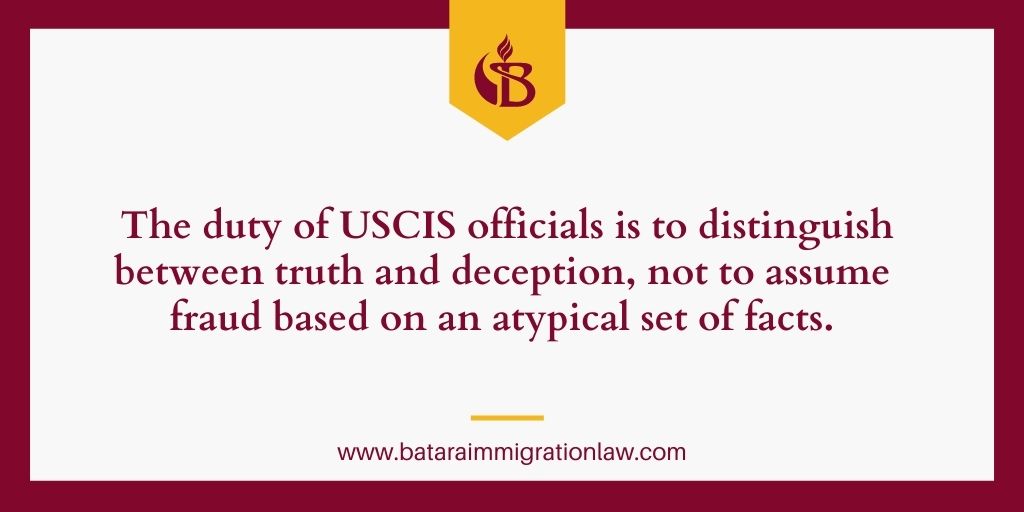
Ever wonder what goes into a marriage green card fraud determination by immigration officials?
Although I have written fairly extensively on immigration fraud, my focus has been on teaching innocent immigrants how to avoid con artists.
But what about immigrants, with true marriages, accused of wrong-doing by the government?
Too often, as an appellate attorney, I’ve seen cases where the government alleges a green card marriage petition fails because the couple is suspected of committing an immigrant sham.
How does this happen?
It occurs, more often than not, because the government perceives certain answers on permanent residence applications as potential “indicators” of marriage fraud. In many cases, a Stokes interview, that is, an in-depth interview or a second interview, is set, enabling the government to address such concerns.
When such areas of concern are not supported by ample evidence, efficiently organized and presented, the possibility of an adverse government decision based on the USCIS fraud indicators is heightened.
Immigrants and their spouses should not be shocked or upset when immigration authorities attempt to weed out the bad actors.
Instead, they should take the time to carefully prepare to address the government’s likely inquiries.
This article is intended to help immigrants take that step.

Why Understanding The USCIS Green Card Fraud Indicators Checklist Is Crucial
In an article written for the Immigration Prof Blog, a law professor at the University of Oklahoma, Kit Johnson, discussed how she trains future lawyers to understand the USCIS fraud indicators checklist used by officers to spot false marriages.
She stated that one of her favorite Immigration Law projects is to give her students a copy of the USCIS Fraud Referral Sheet, then ask them to evaluate the merits of three applications, taking into account the factors stated in the sheet.
She noted the exercise focuses on the role of lawyers in preparing clients and cases for USCIS green card interviews.
Professor Johnson’s emphasis is well placed.
Too many cases where the government asserts clients have perpetuated a sham marriage are due to lackadaisical structuring of supporting evidence.
Most, if not all, of the USCIS factors are subject to varying interpretations in a wide range of situations.
During my career as an mmigration lawyer, I have battled on countless occasions to clarify the government’s depiction of such issues.
Their inclusion in a fraud checklist does not surprise me.
But just a quick glance at the factors listed should cause any immigrant rights advocate a degree of concern about how certain human behaviors, which may seem normal to many individuals, could lead to a suspicion of immigration fraud.
This means laying the groundwork for clients to adequately address the USCIS fraud indicators checklist is a sine qua non of good lawyering.
Otherwise, how are immigrants and their spouses going to know that careless wording of their answers or lack of submission of supporting evidence carries the potential for case denial?
For instance, take the following partial list of potential fraud indicators: being late to the interview, extreme nervousness, and eye contact.
Being Late
In large cities like Riverside, being late to a USCIS green card marriage interview is not out of the ordinary. Traffic, weather, poor roads all contribute to driving futility. Yet, in many instances, this is a common mistake in green card marriage cases that can be avoided.
Extreme Nervousness
What is extreme versus non-extreme nervousness? And isn’t nervousness the norm?
The USCIS checklist also includes lack of interest as a potential fraud indicator.
Sounds like a double-edged sword.
Eye Contact
What about it? Is too much or too little eye contact the tell-tale sign?
Like nervousness is there some perfect amount of eye contact or nervousness which a legitimate, but not a fraudulent, candidate for immigration benefits exhibits?
What about the effect of cultural upbringing?
Here is the checklist pertaining to I-130 petitions filed on behalf of marriage green card seekers:

I-130 Marriage-Based Petitions
Tell-Tale Immigration Fraud Warning Signs
As a permanent resident attorney, it is clear that the possible fraud factors for immigrants trying to obtain a green card via a family-based visa petition are as potentially arbitrary as the general fraud factors.
Consider these warning signs.
A Short Time Between Entry And Marriage
Does it matter if the couple knew each other before reuniting in the United States? Does it matter how the immigrant spouse entered the country? What if the couple met through an online dating service?
And what’s a short time?
In my view, all of these questions are open to many different permutations of human relationships.
Unusual Number Of Children And Large Discrepancy In Age.
What’s an unusual number of children?
What’s a large discrepancy in age?
Would these factors matter if the couple has known each other a long time?
But, then, what’s a long time?
Divorce And Marriage Dates Are Close.
Really?
Some folks want to rebound from disastrous relationships as quickly as possible.
How Marriage Fraud Indicators
Can Destroy Your Green Card Case
Many immigrants who represent themselves without an attorney often fall short due to simple mistakes which could be avoided with pre-planning.
Why Marriage Shams Need To Be Called Out
But what about the not-so-innocent immigrants?
As reform advocates, we cannot turn a blind eye to immigrants who attempt to dupe the system.
Not only are such actions wrong per se. They also destroy any positive momentum we build with reform fence-sitters and lukewarm legislative allies.
We need to condemn such actions, even when our heart wants to help as many immigrants as possible.
Hence, the government’s use of fraud indicators is not unreasonable.
Instead, we should ask, in the interests of fair representation, what factors does the government assess to pinpoint those trying to illegitimately sneak past green card gatekeepers? And does the government fairly assess our clients’ responses?
Distinguishing Truth From Deception
To be fair, I understand how these factors made their way onto a USCIS Fraud Checklist.
They are relevant factors – but only if they are evaluated through a totality of the circumstances lens.
To the extent such factors are pertinent government considerations, immigration agents should not view unusual situations in a unduly rigid manner.
The duty of USCIS officers is to distinguish between truth and deception, not to assume fraud based on an atypical set of facts.

This is not an easy task.
After all, the real world is not solely comprised of perfect love and human relationships.
The internet age, in which we live, creates an extra risk. Many times folks share pictures, videos, and other items of friends, cousins, and ex-flames. They appear to be evidence of fraud on social media. They do not remove them.
And then there is the adverse impact of real scammers – some of them crooked law enforcement and immigration officials – making life harder for countless legitimate petitioners and their immigrant spouses and family members.
As advocates for our clients, our obligation is to care for, protect, and guide our clients safely through the permanent resident process.
This requires thorough evaluation of their personal circumstances and diligently getting them ready to testify about those circumstances.
By Carlos Batara, Immigration Law, Policy, And Politics




